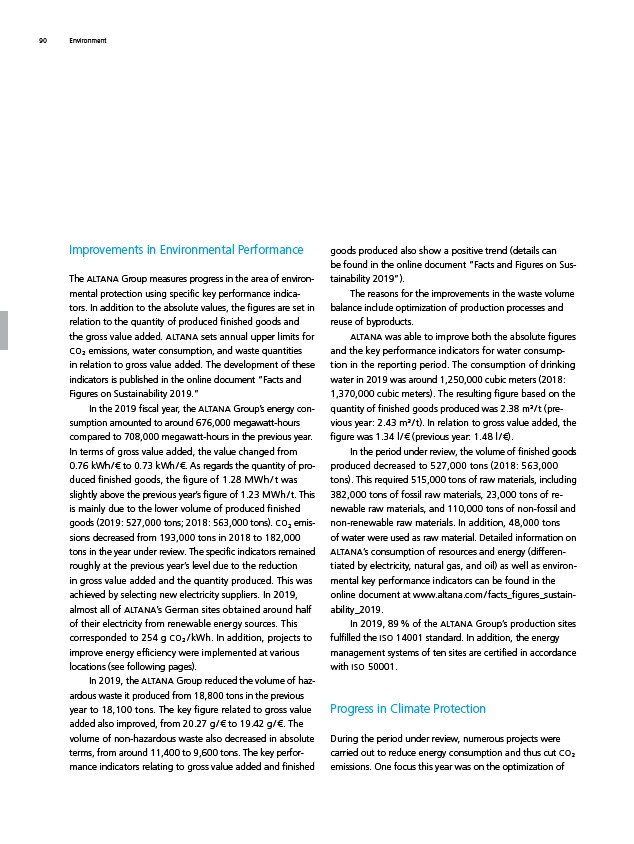
goods produced also show a positive trend (details can
be found in the online document “Facts and Figures on Sustainability
2019”).
The reasons for the improvements in the waste volume
balance include optimization of production processes and
reuse of byproducts.
ALTANA was able to improve both the absolute figures
and the key performance indicators for water consumption
in the reporting period. The consumption of drinking
water in 2019 was around 1,250,000 cubic meters (2018:
1,370,000 cubic meters). The resulting figure based on the
quantity of finished goods produced was 2.38 m³ / t (previous
year: 2.43 m³ / t). In relation to gross value added, the
figure was 1.34 l / € (previous year: 1.48 l / €).
In the period under review, the volume of finished goods
produced decreased to 527,000 tons (2018: 563,000
tons). This required 515,000 tons of raw materials, including
382,000 tons of fossil raw materials, 23,000 tons of renewable
raw materials, and 110,000 tons of non-fossil and
non-renewable raw materials. In addition, 48,000 tons
of water were used as raw material. Detailed information on
ALTANA’s consumption of resources and energy (differen-
tiated by electricity, natural gas, and oil) as well as environmental
key performance indicators can be found in the
online document at www.altana.com / facts_figures_sustainability_
2019.
In 2019, 89 % of the ALTANA Group’s production sites
fulfilled the ISO 14001 standard. In addition, the energy
management systems of ten sites are certified in accordance
with ISO 50001.
Progress in Climate Protection
During the period under review, numerous projects were
carried out to reduce energy consumption and thus cut CO²
emissions. One focus this year was on the optimization of
90 Environment
Improvements in Environmental Performance
The ALTANA Group measures progress in the area of environmental
protection using specific key performance indica-
tors. In addition to the absolute values, the figures are set in
relation to the quantity of produced finished goods and
the gross value added. ALTANA sets annual upper limits for
CO² emissions, water consumption, and waste quantities
in relation to gross value added. The development of these
indicators is published in the online document “Facts and
Figures on Sustainability 2019.”
In the 2019 fiscal year, the ALTANA Group’s energy con-
sumption amounted to around 676,000 megawatt-hours
compared to 708,000 megawatt-hours in the previous year.
In terms of gross value added, the value changed from
0.76 kWh / € to 0.73 kWh / €. As regards the quantity of produced
finished goods, the figure of 1.28 MWh / t was
slightly above the previous year’s figure of 1.23 MWh / t. This
is mainly due to the lower volume of produced finished
goods (2019: 527,000 tons; 2018: 563,000 tons). CO² emis-
sions decreased from 193,000 tons in 2018 to 182,000
tons in the year under review. The specific indicators remained
roughly at the previous year’s level due to the reduction
in gross value added and the quantity produced. This was
achieved by selecting new electricity suppliers. In 2019,
almost all of ALTANA’s German sites obtained around half
of their electricity from renewable energy sources. This
corresponded to 254 g CO² / kWh. In addition, projects to
improve energy efficiency were implemented at various
locations (see following pages).
In 2019, the ALTANA Group reduced the volume of haz-
ardous waste it produced from 18,800 tons in the previous
year to 18,100 tons. The key figure related to gross value
added also improved, from 20.27 g / € to 19.42 g / €. The
volume of non-hazardous waste also decreased in absolute
terms, from around 11,400 to 9,600 tons. The key performance
indicators relating to gross value added and finished